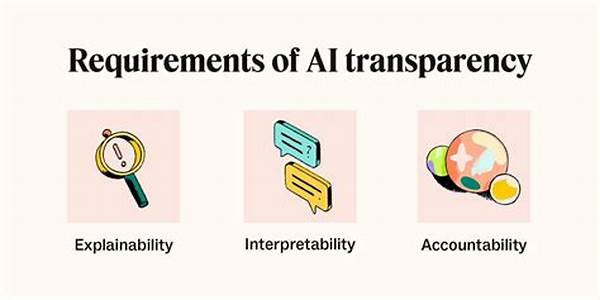In an era where artificial intelligence (AI) is increasingly interwoven into the very fabric of our daily lives, the concepts of transparency and accountability are paramount. AI systems are responsible for critical decisions in areas ranging from healthcare diagnostics to criminal justice and even autonomous driving. As such, ensuring that these systems operate on transparent principles and are held accountable for their actions is not just a lofty ideal, but an absolute necessity. By implementing robust AI transparency and accountability measures, we can mitigate the risks associated with AI, enhance trust among users, and ensure ethical compliance in AI applications.
The first step in this journey is understanding the importance of AI transparency. When AI systems are transparent, users can see the logic behind the outcomes. This transparency increases trustworthiness and allows for better user interaction because decisions made by AI are no longer black boxes but open books. Imagine a hospital making important diagnoses through AI systems; transparency in these decisions can mean the difference between trust and skepticism from both patients and healthcare professionals.
Accountability, on the other hand, refers to the responsibilities of developing and deploying AI systems ethically. It ensures that AI creators and operators answer for the actions of these systems. If an AI system fails, accountability measures would require an investigation to determine if the fault lies within the system’s design or operation and to make changes to prevent future errors. Organizations can start by establishing clear guidelines and policies that track how AI decisions are made and who is responsible for these decisions. Doing so not only safeguards users but also encourages responsible innovation.
The Impact of Effective AI Measures
The implementation of AI transparency and accountability measures creates a ripple effect that impacts multiple sectors. For instance, in financial technology, transparency in AI-driven recommendations for investment can build client trust. In education, AI accountability ensures that machine learning tools assess students fairly without bias. These measures can potentially transform industries by ensuring that AI applications are used responsibly and ethically, contributing to a broader societal good.
—
Discussion: Navigating AI Transparency and Accountability
Balancing Innovation with Ethical Responsibility
The discussion around AI transparency and accountability measures is more crucial than ever. While AI opens up a Pandora’s box of opportunities, it’s not without its fair share of challenges. Balancing innovation with ethical responsibility requires a clear vision and commitment to transparency and accountability.
The magic of AI lies in its ability to choose and predict, but the intricacies behind these choices often remain cloaked in mystery. A single rogue AI decision has the potential to create chaos, making transparency indispensable. Enter AI transparency and accountability measures that allow stakeholders to track and understand how AI models work. This sense of clarity reassures not just techies and experts but also the broader public who are affected by these technologies daily.
How Can We Ensure Adequate Measures?
The next step in this discussion focuses on how we can ensure the effective implementation of such measures. When dealing with AI, transparency means being open about the data sources, decision-making processes, and even potential biases present within models. Accountability, on the other hand, demands responsibility not only from AI developers but also from companies that deploy these tools.
One way of tackling this is through legislation and policies. By setting legal frameworks, nations can make AI transparency and accountability measures a compulsory part of AI use and development. Furthermore, active dialogues about ethical guidelines are essential between stakeholders, including government bodies, academia, and private sectors.
Conclusion: Driving Positive Change
In conclusion, the path forward involves a strong push towards advocacy and education regarding these measures. We need to foster a culture that values transparency and holds AI accountable for its influence. AI has the potential to streamline processes, foster innovation, and deliver solutions that once seemed impossible. However, its success largely depends on our commitment to these measures, ensuring that the AI of today and tomorrow is both ethical and effective.
—
Summaries on AI Transparency and Accountability Measures
—
Objective: Promoting Awareness and Action
The primary objective of advocating AI transparency and accountability measures is to create an informed community that understands and values the importance of ethical AI governance. By implementing these measures, organizations can not only protect themselves from potential risks but also contribute positively to the AI ecosystem. Imagine an AI landscape where every decision is clear, every error is caught in time, and every user can engage with AI systems confidently. This is the future that transparency and accountability promise.
It’s not just about technical compliance; it’s about fostering a relationship of trust between technology and its users. With greater awareness, more businesses and end-users can demand higher standards, which, in turn, propels innovation while safeguarding everyone involved. By embedding these measures into daily operations and decision-making processes, we lead AI into a future where it serves humanity with dignity and integrity.
Building a Framework for Transparency
Steps Toward Effective Measures
1. Educate Stakeholders: Ensure everyone involved in AI development understands the significance of these measures.
2. Implement Guidelines: Create comprehensive policies that outline expectations for transparency.
3. Enforce Compliance: Regular audits and assessments can ensure ongoing adherence to standards.
4. Promote Open Communication: Maintaining an open dialogue fosters an environment of accountability.
5. Encourage Ethical Use: Reward companies and developers who prioritize ethical AI practices.
6. Ingrain AI Ethics in Culture: Make transparency a core part of an organization’s ethos.
7. Harness Innovation Responsibly: Balance cutting-edge technology with the duty of care.
8. Seek Diverse Perspectives: Include voices from different sectors for a holistic approach.
In conclusion, embracing AI transparency and accountability measures is not just wise; it’s a necessity. The road ahead may be challenging, but with concerted effort, we can shape an AI future that embodies trust, responsibility, and innovation.

